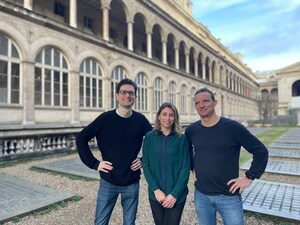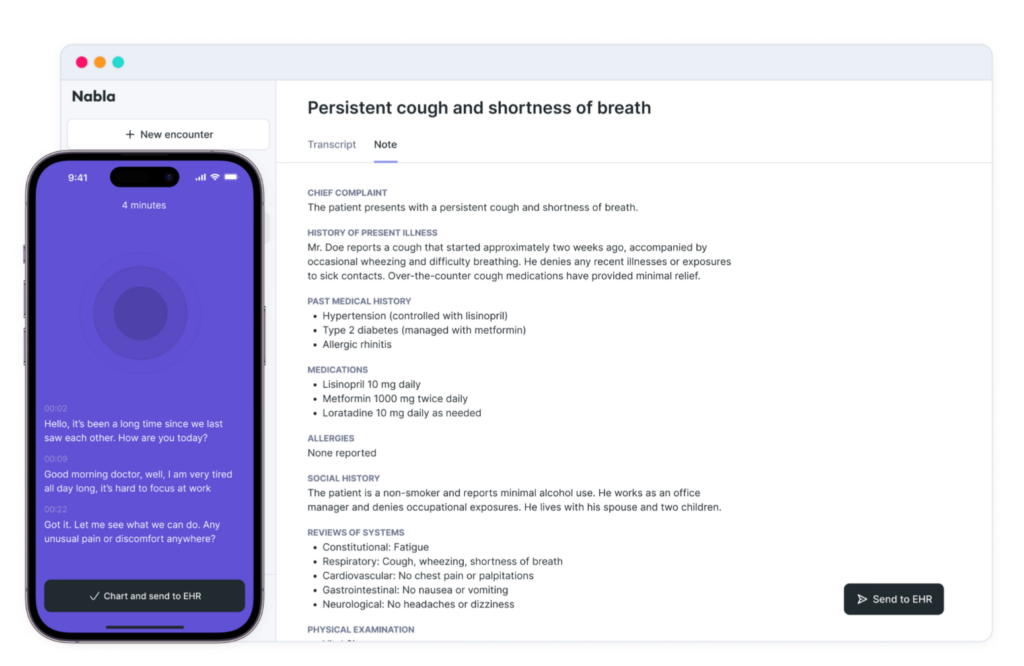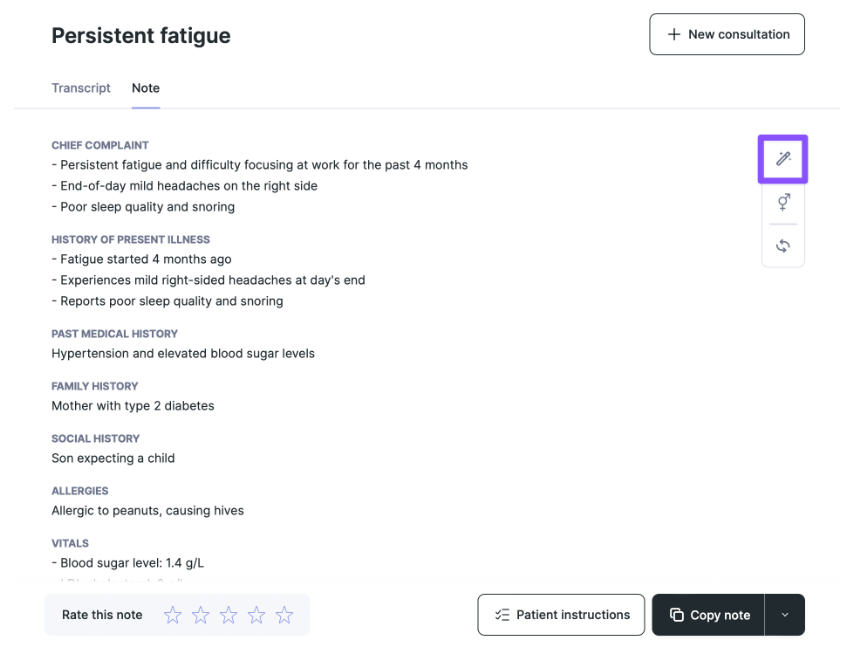TL;DR: Nabla’s team of AI scientists and researchers have built a robust ambient AI documentation assistant for physicians and clinicians. Everyone who uses it loves it. It’s accurate. It works across 55+ specialties and 35 languages. They don’t store or train models on your data. Physicians and health systems who use/implement Nabla can expect more time back (at least 2 hours saved a day), better documentation leading to downstream integrations and better patient care activations, and increased clinician satisfaction, leading to lower burnout.
Learn more about what they’re doing here.
Nabla: Restoring the Joy of Medicine
There aren’t many firms with a culture like Nabla’s. One that exudes passion for what they work on. Laser focused on a single goal: making technology to improve the lives of practicing physicians and clinicians, for the betterment of patients.
I’ve met with Nabla’s team in-person, and I’ve also seen the impact of Nabla’s passion for their products in real time. I’ve watched as Nabla grew from a scrappy startup into a fierce competitor.
But they’re not primarily competing against other players in the space. They’re competing against the administrative monstrosities physicians face on a daily basis.
Physicians deserve better tools—ones that help them practice medicine without drowning in documentation. Nabla delivers on that promise, offering a fast, customizable, and deeply intuitive AI assistant that saves doctors at least 2 hours per day while ensuring high-quality, structured notes.
So today, we’re diving into the transformative impact the AI-enabled ambient documentation technology presents as the best use case for AI in healthcare to date. And we’ll walk through how Nabla is restoring the joy of medicine – by saving time and energy once spent on debilitating documentation – for tens of thousands of physicians and clinicians across the nation.
Here’s the Nabla story.
Nabla Origins and Grassroots Culture

Nabla was founded by Alexandre Lebrun (CEO), Delphine Groll (COO), and Martin Raison (CTO)—a trio with plenty of AI and healthcare tech expertise. Lebrun, a serial entrepreneur, had previously sold AI companies to Nuance and Facebook. Their vision in forming Nabla was, and is, clear: AI should help humans, not replace them.
To really understand the problem and see the best path forward to solve administrative burden on providers, Nabla’s team ran their own clinics in the UK for a year. The biggest lesson was obvious—doctors were drowning in documentation. Determined to dive into the deep end (and it IS the deep end), the team spent four years researching and fine-tuning their AI models to make paperwork as effortless as possible.
Nabla’s grassroots, user-focused culture has permeated into its success. Everyone within the organization is driven to make the product better because (1) they know what the hell they’re doing and (2) they know the impact they can have on clinicians’ and patients’ lives.
At the core of what they do – their team’s north star – is a set of simple questions: “how can I make the physician and clinician experience better? How can I make the patient experience better?” If Nabla maintains a radical focus on their core user, then everything else will fall into place from there.
This north star mission drives all other outputs. Nabla’s team is incessantly messaging clinicians and physicians on feedback and iterations. In fact, this feedback loop is structurally purpose-built into Nabla’s model: make it easy for providers to give feedback so Nabla can quickly improve the product. Engineers are deeply embedded into physician workflows and pain points, obsessed with making better experiences. Internally, they share war stories and victories in a Slack channel appropriately named “Product Love.”
Nabla also did something different to commercialize and grow, too. The team made their AI assistant instantly accessible to physicians. Instead of jumping through hoops for a demo, physicians and clinicians can try it out for free on their website. That “see it to believe it” approach has led to rapid, organic adoption.
The product-led growth strategy has worked wonders. Since starting in 2018, then officially launching the ambient AI assistant in March 2023, over 50,000 physicians and clinicians use Nabla daily and save up to 2 hours per day. Nabla is deployed in over 100 organizations, and integrates with all major EHRs, including white-labeling its ambient AI assistant to power EHR ambient solutions like NextGen or Greenway Health. They’ve raised $49M in total including a $30M Series B.
But as they themselves would tell you, all of that success is so secondary to their impact on those 50,000 (and counting) physicians and clinicians.
Nabla’s Value Prop to Physicians and Clinicians: Time
Nabla’s mission isn’t about hitting any sort of metric. It’s about alleviating the administrative burden on providers. About finding the spark that drew them to medicine – keeping them focused on the patient and not as perpetual typing machines during those visits. Medical note documentation is one of the leading causes of burnout among physicians.
So the value prop is simple: “let us have a maniacal focus on our documentation product. We’ll make it work in multiple specialties. Multiple languages (35 and counting, in fact). It’ll pick up sound in low-fidelity environments like the emergency department. It’ll even capture diagnosis codes. And you? You just focus on the conversation at hand. Oh, and by the way, you can customize your note template any way you like. If you’re an ER doc, go ahead and capture everything. PCP? Here’s a more streamlined note.”
Physicians and clinicians have experienced:
- More time with patients and their own families (crazy for a doctor, I know);
- Less time spent documenting and lower stress/cognitive load;
- Comprehensive notes that meet coding standards CDI requirements
- More professional satisfaction and better retention; and
- Lower burnout rates, including a host of other clinician benefits
Stated differently, using Nabla leads to material benefits, both for the physician’s well being but also economically.
Inside Nabla, and how it’s Differentiated

Value props are easy. But how is Nabla different from other solutions?
Customization: No two doctors practice the same way, and Nabla gets that. Emergency physicians often need exhaustive, detailed notes capturing every aspect of a fast-moving situation, while primary care doctors may want concise, problem-oriented summaries. Nabla adapts to both approaches effortlessly. Compared to other AI-enabled solutions, Nabla gives providers more control over the level of detail captured, offering a truly flexible experience. This differentiator – customization – is where Nabla thrives. Many ambient AI assistants are just GPT wrappers, offering generic note-taking capabilities without the deep healthcare-specific customization that Nabla provides.
Speed and Fidelity: Speed and accuracy are everything when it comes to clinical documentation. Nabla generates notes in under 5 seconds, outpacing many other ambient AI solutions. And with 95% accuracy, physicians can trust that their notes will be high-quality right from the start, requiring little to no edits. Clinicians who have tested ambient solutions consistently report that Nabla’s AI generates more precise and reliable notes, especially in complex or noisy environments. Nabla also ranked higher than all other ambient AIs when it came to note accuracy for specialty care.
Accessibility and Ease of Use: One of the standout features of Nabla is how easy it is to start using. While many competitors require clinicians to go through a drawn-out demo process or enterprise agreements, Nabla allows individual providers to access and try the platform for free, directly from their site.
Beyond ease of access, Nabla offers:
- Customizable note templates, allowing providers to tailor documentation to their specialty and preferences.
- Dictation capabilities, streamlining clinical workflows by enabling speech input across 250+ EHRs
- Automatic ICD-10 code generation, with upcoming expansions to include HCC and CPT codes.
- Patient-friendly visit summaries, breaking down clinical information in clear, understandable language.
- Ambient dot phrases, verbal shortcuts enabling quick note entries.
Integration: While some AI documentation tools focus exclusively on Epic, Nabla takes a broader approach. It integrates with Epic, Cerner, athenahealth, Greenway, NextGen, Altera Health, and other specialty EHRs. Serving the largest and most diverse pool of healthcare organizations is at the core of Nabla’s approach.
Co-development with Physicians: As mentioned, one of Nabla’s biggest strengths is its deep collaboration with clinicians, ingrained in its culture. This isn’t just AI built in a lab—it’s built with real physician input, ensuring the tool actually works the way doctors need it to. In pediatrics alone, Nabla supports over 20 subspecialties.
Overall, Nabla’s ambient AI assistant is purpose-trained to look at the whole conversation, identify what is relevant, and make decisions on what to exclude or include (which involves individual physician tweaks and training). Physicians can say what areas of conversation are important to them and maintain those preferences. Built-in features like Nabla’s Magic Edit allow physicians to create customized instructions for note templates.

Nabla: the Results in Action
I mentioned how Nabla works closely with their providers, and they’ve shared with me some great internal interviews from physicians at partner health systems who have been practicing for years. If you don’t want to take my word for it, take theirs.
For instance, Dr. Lovinger is a practicing Hospitalist, Associate Chief Medical Officer, and Chief Informatics Officer at Carle Health with almost 30 years of experience working at Carle Health. Here’s what he had to say:
- First Thought When Trying Nabla: The rare product that lives up to the hype. Truly a game changer.
- What is your specialty, and what inspired you to pursue it? I’m a hospitalist. I enjoy the challenge of taking care of patients who are seriously ill, but not so ill that you are unable to have a relationship with them. I feel like my work makes a difference in people’s lives.
- How does your specialty influence your documentation needs? It definitely varies depending on your specialty. A lot of what I document is used to determine medical necessity.
- What’s your favorite success story or memory from using Nabla? Once, when I was using a dedicated iPod for a listening device, I left the iPod at home. I panicked for a moment, because I couldn’t imagine how I was going to get through the clinic without Nabla – that’s how essential it has become to my workflow.
- If you were to describe Nabla in one sentence to a colleague, what would you say? It makes better notes, with less effort. And it really works as advertised.
Joy restored, one doc at a time.
Justin R. Upwell, LPC, LAC is a Primary Care Behavioral Health Consultant and Behavioral APP at Denver Health, working 9 years as a Clinical Mental Health Counselor. You’ll find many parallels between him and Dr. Lovinger. Differences, but so many of the same pain points addressed by Nabla:
- What is your specialty, and what inspired you to pursue it? My specialty is Primary Care Behavioral Health, also known as Integrated Behavioral Health (IBH), a field that aligns with my personal interests and values. When I joined Denver Health in Integrated Behavioral Health, I had a limited understanding of the field. However, over the past four years, I have discovered my true passion for PCBH. I am drawn to the diverse range of presenting problems and the opportunity to support patients not only in addressing psychological concerns but also in improving their physiological well-being.
- How does your specialty influence your documentation needs? An essential aspect of PCBH/IBH is same day consult visits. The patients come to see their PCP, a need is identified that a BHC can help with, and we see the patient the same day during or at the end of their PCP visit. This increases our access to the patients since they are already here, and it allows us to support the PCP in developing their treatment plan. These consults can be short, as little as 5 mins, and in a 4 hour period we can see anywhere between 5-10 which leads us to jump from one to the next. Concurrent documentation is quite challenging in these types of visits.
- What’s your favorite success story or memory from using Nabla? I have worked with a patient on and on for a few years who has a significant speech impairment due to trauma to his jaw and mouth some years ago. During a phone visit using Nabla, he and I were talking about some care coordination needs and I struggled to understand him at a few points. At the end of the visit, when I reviewed the note and the transcript I noticed that he had said “my brother helps me with scheduling my appointments”. I did not hear him say this, so coordinating with his brother was not a part of the plan. I called the patient back, verified he had said this, and then looped his brother into the care plan. If it wasn’t for Nabla, I would have missed this and maybe the parent would have been lost to follow-up or would have had his care unnecessarily delayed.
- If you were to describe Nabla in one sentence to a colleague, what would you say? This is a new tool for behavioral health care that not only improves quality of patient care, but also quality of life for the provider.
Trust restored, one patient connection at a time.
Nabla the Partner

Today, more than 100 healthcare organizations rely on Nabla, ranging from large health systems to medium-sized clinics and small practices. Notable customers include some of the nation’s most innovative and leading healthcare institutions, such as Children’s Hospital of Los Angeles, Carle Health, Denver Health, University of Iowa Health Care, Mankato Clinic, StratumMed Group, Brightside Health, and Thyme Care.
Beyond these personal testimonials, Nabla has seen material adoption and results within the context of the partnerships at hand. Some recent partnerships and metrics tracked:
With Carle Health:
- 55% saved at least one hour on documentation daily.
- 89% are very likely to recommend Nabla.
- 78% likely to replace current documentation methods with Nabla.
With Denver Health:
- Rapid adoption by 400+ clinicians in the first week;
- 16,000+ encounters in the first month.
- Clinicians reduced note-typing by 40%, with 82% experiencing less time pressure.
- Up to 15 points increase in patient satisfaction scores.
And finally, with the University of Iowa Health Care:
- 30,000 notes generated in 6 weeks.
- Burnout scores dropped from 4.2 to 3.2, below the burnout threshold (FPI index).
Nabla’s customer success team wants to be true partners to a growing list of organizations. They work hard, and their customers want to be collaborative in a space as important as this, holding such a significant impact on patients and providers. Feedback for Nabla’s customer success team is always overwhelmingly positive. In the latest survey, the team scored an outstanding 4.75 out of 5.
Often the biggest differentiator can lie in being human, and doing the right thing.
To date, Nabla onboards a new health system or provider organization on a weekly basis, on average. Nabla is currently powering over 10M encounters annually – and growing.
I asked the Nabla team what common questions, concerns, or pain points their partners had in conversation with them. They ranged from the required lift of a technology implementation, to provider adoption levels, to data privacy concerns.
The questions are valid, and implementations of new tech are always hairy. But many of Nabla’s customers noted how ‘unexpectedly easy’ it was to integrate and onboard. Dr. Blum, Chief Health Information Officer and Associate Professor of Anesthesiology at UIHC, highlighted how their collaboration with Nabla helped streamline clinician training through online video courses. “We didn’t have to go clinic by clinic to coach every person on this. We were able to implement it smoothly, without a lot of brouhaha.” (side note: I don’t think I ever thought ‘brouhaha would show up in Hospitalogy but here we are).
As we’ve seen from the metrics above, physicians and clinicians genuinely use Nabla. Nabla retains 90% of its users, who actually use the note in their day to day practice. Denver Health’s associate chief of AI and digital health, Dr. Daniel Kortsch even mentioned “I get spontaneous hugs in the hallway” because they gave Nabla to their physicians and clinicians. When’s the last time you heard that about a tech implementation in healthcare?
Finally, unlike other solutions, Nabla doesn’t store customer data nor does it train its models on customer data. From an AI governance perspective this is important to customers they’ve spoken with. Nabla also does not retain any audio data, ensuring the highest levels of confidentiality and compliance with privacy regulations. Nabla is HIPAA compliant, GDPR, SOC2 Type 2 and ISO 27001 certified. Read their resource on AI and governance / compliance from Nabla here.
Restoring the Joy of Medicine, One Onboarding at a Time
Nabla isn’t done yet. They’re growing like wildfire, and it’s easy to see why after reading the testimonials and differentiators – which start with internal culture and passion. As Nabla enters 2025, it is expanding its offerings to further enhance clinical workflows. The team believes AI is just at the beginning of its potential and can do much more to support clinicians.
Nabla’s mission is simple yet profound: remove the burdens that distract clinicians from the work they love. By leveraging best-in-class AI, fostering deep health system partnerships, and maintaining an unwavering commitment to quality and compliance, Nabla has emerged as a leading ambient AI documentation solution in healthcare.
For clinicians, it means more time with patients and less time in front of a screen. For patients, it means higher-quality care and better outcomes. And for healthcare as a whole, it signals a future where technology supports—not supplants—the human connection at the heart of medicine.
The joy of medicine is making a comeback, and Nabla is leading the charge.
Join my Hospitalogy Membership! If you’re a VP or Director working in strategy or corporate development at a hospital, health system or provider organization, you will get a lot of value out of my community as I purpose-build the content, fireside chats, and conversations for this group. Join for free today.
